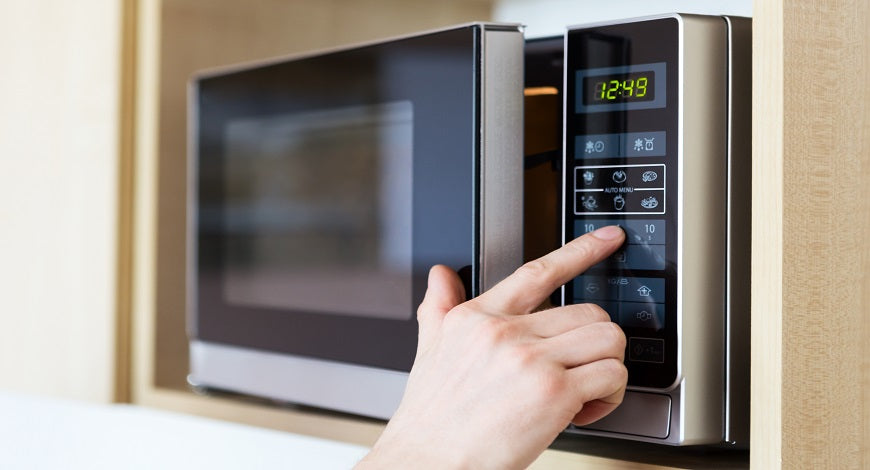Microwave ovens are quick and convenient for anything from warming yesterday's leftover lasagne, to cooking today's vegetables, and baking cakes. They tend not to burn food, so the dishes are easier to clean.
Your family may pay a high price for this speed and convenience, however, which should make you think twice about using them as the food becomes perpetrated by microwaves and violently mutilated.
How Microwave Ovens Work
The frequency of the microwaves generated by your microwave oven's magnetron is around 2,450 megahertz. Waves at this frequency are absorbed by the molecules in water, fats, and sugars without being absorbed by the material from which your containers are made (plastic, glass, and so on.)
When the food absorbs the waves, the food's molecules shift between positive and negative polarity at millions of times per second. These rapid changes create the molecular friction that heats the food. In other words, the molecules inside your food AREN'T heated just as they are.
The Consequences of Microwaving Food
Microwaved Food is Unnatural
For those who spend a lot of money on natural organic food because they believe that unprocessed food is healthier, the food is nowhere near its natural state when it leaves the microwave.
Instead, it has been thoroughly processed by putting its molecules through unnatural polarity changes and the friction that results from these. It is, hence, a cooking method that all adherents to a natural, raw or non-genetically modified diet should reject out of hand to remain consistent with their belief in the health benefits of minimum processing.
Microwaving Produces Carcinogenic Chemicals
Microwave ovens produce acrylamide, a chemical that can cause cancer. So do other cooking methods, of course, especially grilling on a hot grill and frying in oil. On a grill you can usually identify the acrylamide as the little black spots on the food that develop when you do not move the food around the grill enough.
Some researchers have discovered that microwaving produced more acrylamide than frying at 180 degrees, which is around 50 degrees lower than the oil in which one usually fries fish and potato chips. The acrylamide is produced even by the weakest 500 watt microwave ovens.
Furthermore, the higher the wattage of your microwave oven, the more acrylamide it produces on the food, with the 700 watt ovens being almost 50 per cent worse than the 500 watt ovens. Many people have a 1,000 watt oven at home.
The Nutritional Value of Microwaved Vegetables
Most studies show that microwave cooking destroys the vitamins in vegetables, especially vitamin C, a powerful antioxidant.
In addition, it also destroys proteins, sugars, chlorophyll and flavonoids, the healthy pigments that make vegetables green and yellow.
At the worst end, the vitamin C loss is up to 90 per cent, the chlorogenic acid loss from potatoes is about 100 per cent, and the flavonoid loss from broccoli and spinach is around 90 per cent.
It is, thus, safe to conclude that we should keep vegetables out of the microwave if we want them to be properly nutritious.
The awkward finding by these studies, however, is that boiling in water and stir-frying are only a little bit better at preserving the nutrients in vegetables than microwaving is; boiling because the nutrients are lost in the water, and stir-frying because the nutrients are destroyed by the high temperature of the oil. So switching from microwaving to water boiling or stir-frying is not a great solution. Steaming and waterless cooking are the only cooking methods that allow vegetables to retain most of their nutritional value.
The Effect of Microwaving on Vitamin B12
A Japanese team discovered in 1998 that the microwaving of beef, pork, and milk reduced their vitamin B12 content by about 40 per cent. Vitamin B12 is present in no unfortified plants and occurs in only small amounts in animal products. We should not lose the little we can obtain.
A lack of vitamin B12 has been linked with anaemia, weakness, exhaustion, paranoia, hallucinations, and early dementia.
The Nutritional Value of Microwaved Proteins
At this stage most researchers argue that the microwaving of meat and pulses increases their protein digestibility and their retention rates of fatty acids and both B-vitamins and minerals. It also decreases their flatulence-causing substances.
However, pressure cooking increases their starch and protein digestibility even more than microwaving while simultaneously preserving their vitamins and minerals, so this is the way to go if you want to avoid your microwave oven.
Moreover, a pressure cooker with the appropriate settings can control its own temperature, prevent the food from burning and developing cancerous chemicals, and can also work unattended; a far better solution all around.
The Nutritional Value of Microwaved Infant Formula
There are few things more annoying than waiting for a bottle of milk or formula in a bucket of hot water to warm fast enough while a baby screams for food.
Recent studies demonstrate that microwaving infant formula and breast milk will not destroy their nutrients and anti-bacterial factors if it is kept under 60 degrees celsius, which is why so many mothers use microwaves to warm their infants' food.
Older studies are nowhere near as comforting though. An older study by Doctor Lita Lee, published in 1992, argued that the microwaving of baby formula caused trans-amino acids to be converted into synthetic versions that are either non-nutritious or toxic. This study is not available for its methodology to be scrutinised, so the credibility of its conclusion is unknown.
In 1992, a team from Stanford University found that microwaved milk warmed to 25 degrees lost most of its anti-infectant properties and its antibodies, and created an environment in which bacteria could flourish.
Many new mothers would not consider this a chance worth taking, especially as infants need milk to provide antibodies and other anti-infective properties to boost their still undeveloped immune systems.
The Effect of Microwaves on Heavy Metals
Researchers have discovered that fish should not be microwaved, as it increases the heavy metal concentration that exists in most creatures and plants that come out of the oceans. Whether this also applies to vegetables and grains that collect metals from the soil in which they are planted seems not to have been studied, but the risk cannot be discounted.The Risks of Convenient Microwaveable Containers
Except for the bit of heat reflected by the food, the inside of the microwave oven is at room temperature because the microwaves do not cause friction in air, metal, plastic, or any other molecules. That is why makers of instant food cover it with a thin semi-permeable foil or plastic sheet under which the food can create an oven-mimicking rise in the air's temperature to form a crispy crust, which microwaves cannot do.
Chemicals from aluminium foil and from many types of plastic containers leach into food, especially when they are heated. These chemicals have been found to cause cancer and various harmful hormonal changes. If you do not cover dishes with such unhealthy sheets, however, you cannot have a crispy topping that is desirable to some.
The Effect of Microwaves on Blood
In 1991, Oklahoma saw a lawsuit brought against a hospital for warming blood in a microwave oven before a blood transmission on one of their hip transplant recipients. The patient, who was basically healthy, almost immediately died.
Interestingly, researchers still seem to be in the dark about the changes in the blood that made it so toxic, and this is clearly not an experiment that can be conducted on a real person to verify the result.
Hospitals have certainly not used microwave ovens to warm up blood since then, precisely because the risk is too high that microwaves damage it. Since most of the microwaved food that we eat ultimately end up in our blood, the concern that microwaves can damage some of the substances they heat to such a critical degree still weighs on many minds.
Choose Your Cooking Method Wisely
The most strongly anti-microwave studies were produced in Russia during the 1960s and 1970s, the era when most such research was funded and controlled by its government and not peer reviewed by scientists elsewhere in the world.
No contemporary researchers with more advanced research methods have managed to replicate their extreme findings related to cancer and genetic defects. It is, therefore, not necessary to panic every time your teenager stands near the microwave oven to warm some left-overs.
Still, even after the cooling of the most intense anti-microwave hysteria, some concerns remain. If the microwave is responsible for the majority of your meals, you are certainly missing out on nutrients, including on some essential immune system support. You are also consuming a higher amount of carcinogens than you would with other cooking methods.
Keep these in mind when selecting your cooking methods and relegate the microwave to a secondary role.




























Leave a comment